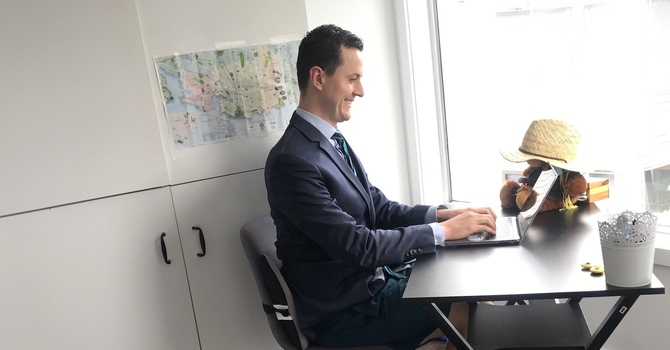Celebrities and (not so helpful) Health Advice

Dr. Marc Bijman, BSc HK, DC
|
--8 minute read -- |
Have you ever searched your symptoms on the internet to find out what is wrong with you?
Your headache could be brain cancer. A cough could be tuberculosis.
We've all done this before! Dr. Google diagnoses us with a debilitating disorder or disease and sends us into hysteria. Only to be calmed down later by a friend, medical professional or our future rational selves.
Very often, celebrities, athletes and media persons can be misleading or incorrect, just like the information from medical sites on the internet. It is difficult as the public will often believe these people of power and fame as credible sources and immerse themselves in their ill-informed beliefs. Although celebrities are usually not trying to cause harm, they often unintentionally end up deceiving the general public and lead people astray from evidence-based medical advice.
My favourite golfer of all time: Tiger Woods
One celebrity with a lot of success and little biomechanical formal training is Tiger Woods.
Tiger Woods has had an immensely successful golf career spanning over 20 years and 15 major golf championships. Being a hero in the American and worldwide community, he has inspired many young females and males to take up the sport of golf. He's by far the most popular golfer of all time, putting golf on the map! In 2019, he won the Masters Tournament and was presented with a medal of freedom by President Donald Trump.
At the height of his success, golf courses would "Tiger proof" their courses in hopes of slowing him down...typically, it did not work.
Tiger Woods is an example of somebody who hasn't promoted some alternative trendy health fad but even in a simple statement about the impacts of running on his joints, still misleads the public when it comes to their health.
In a recent interview with Golf TV, Tiger Woods had this to say:
"If you could go back in time, what advice would he give to your younger self?"
Mr. Woods responded: "Not to run so much."
Tiger then followed it up with:
"Running over 30 miles (50 km) a week for probably my first five or six years on tour pretty much destroyed my body and my knees."
According to Nick Piastowski of GolfTV, Woods would run 4-miles in the morning. He'd then lift at the gym, golf for a couple of hours, and then work on his putting. He'd finish his day with another run or some cross-training (basketball, tennis, weight lifting, etc.).
Woods' career has been stalled by four back surgeries and five knee surgeries, some of which may have been the result of running.
Let's break down five reasons why Tiger Wood's statement on running is inaccurate, misleading and might prove harmful.
1. Conservative Care Should be Utilized First Before Surgery
Conservative care is the use of non-invasive techniques. These techniques should be utilized first:
- Education and Reassurance
- Advice to stay active
- Exercise
- Supervised exercise (with a therapist, coach)
- "You will be okay and we don't have to take further X-rays or MRIs"
- Diet and lifestyle changes
- Nutrition
- Sleep
- Exercise
- Hands-on therapy
- Chiropractic
- Physiotherapy
- Massage therapy, etc.
Studies indicate that conservative care should be utilized first before surgery or other interventions are applied for back pain.
When you have new, recent back pain (ie. your back really hurts all of a sudden), it is advised to not try:
- Opioids
- NSAIDs
- Glucose injections
- Surgery before 12 weeks
To me, somebody who had four back surgeries and five knee surgeries didn't exhaust all avenues of conservative care before proceeding to surgery. It sounds like someone who wanted to get back to peak Tiger brilliance before his body was ready.
Surgery certainly has its place and has helped many people; however, other avenues should be exhausted first.
2. Running and its Effect on the Knees
Most day-to-day tasks come with inherent risk, whether it is driving a car, walking your dog or crossing the street.
Similarly, running may also produce problems such as knee pain, back pain and hip pain. It can also lead to more severe disorders like stress fractures and burnout.
However, there are so many benefits with running; which include:
- Strengthening bones
- Strengthening muscles
- Improves cardiovascular fitness
- Escaping from technology
- Strong social connections
Also, any adverse effects of running can be mitigated by appropriate rest, nutrition, conditioning and supportive running shoes.
Furthermore, research has demonstrated that running may actually decrease your likelihood of developing knee arthritis.
A study published in The Journal of Bone and Joint Surgery shows that the prevalence of arthritis in marathon runners was less than half (8.8%) compared to those of non-marathon runners (17.9%).
Why does this occur? Runners typically have A lower Body Mass Index (BMI) - the numerical value of your weight relative to your height (smaller BMI = more slender). It was suggested that this leads to less pressure on your knees and less knee arthritis.
My advice? It's definitely something you can incorporate in your life but be sure to have a thorough discussion with your local doctor, therapist, or health expert in your community (or online) to decide whether running is right or wrong for you.
3. Rotational Power Required to Play Golf
When swinging a golf club, a lot of power is required. A golf swing requires almost every single muscle in your body to contract, with increased activation of our bigger muscles, the obliques, glutes and pecs.
The strongest position of the spine is in neutral. That is why you don't see Olympic weight lifters rotating or bending their back before a lift. With every degree of rotation, additional torque stress is added to the spine which increases your likelihood of injury.
A golfer like Tiger Woods would probably swing a golf club well over 100x in a week. At an average drive of 285 yards, that is ALOT of rotational power required of his back. Similar to arguments with running, if the adequate technique, conditioning and recovery is taken, golf has the potential to be very beneficial for your physical and mental health. However, when you're competing to win Master's championships, you're not thinking about your spine ten years down the road - you're likely thinking about getting in more repetition to improve your score.
Don't believe me? Back pain is so prevalent in the sport that professionals have even developed there own lift - it's amply named the golfer's lift. Check out this video at the 4:08 mark.
4. Pain Science and The Words That We Use
It is basic human psychology that we get attracted to polarizing statements. Politicians, marketers and major cooperations have been using them for years.
For example, Orange Theory is a fitness company with over $1 billion in systemwide sales. Which of the two statements sounds better:
1. "We Change Lives."
This is the slogan they use on side-walk and billboard signs to promote their company.
2. "We may or may not change your cardiovascular capacity and strength if you stick to our program. However, it will cost you 5 hours of your week, ~$100/monthly, and you may get injured".
Although statement #2 is more accurate, statement #1 is the eye-popping statement that gets your attention. I would do the same thing if I worked in marketing.
This problem is seen a lot in healthcare as well. When patients or clients want our advice on their "tight shoulders," we shouldn't tell them:
"Yes, you have tight shoulders. Let me fix them."
Instead, we should tell them:
"Your "hard" trapezius muscles are not a malfunction of the system, they are the system. The body has gone through millions of years of evolution to get to this point, although it has its flaws, it is one of the smartest mechanisms in the universe. The body is contracting your trapezius (your shoulder muscles) as a protective mechanism - it is done for a reason".
Now, fewer people will be able to comprehend this statement, however, that doesn't make it any less true. Many health care practitioners mean well when they make these statements, however, sometimes they can do more harm than good. And as healthcare practitioners, we must remember the golden rule: Primum non-nocere - First do no harm.
Positive pain science words that you should be hearing from your healthcare professionals:
- You have a strong, durable spine and back
- You don't need me. I'm here to guide you to get you to your goals, but you are strong and capable on your own.
- Find exercises and activities in your life that you love doing
Tiger, I've never heard of anyone winning a major golf championship with "destroyed" knees, so be careful in the words that you say.
5. Evidence-Based Pyramid
The evidence-based pyramid is used by health professionals to determine the credibility of a source of information.
As you go up the pyramid, the evidence is substantiated by more people, it has been reproduced and backed up numerous times. At the bottom of the pyramid, we see ideas, editorials and opinions. Always be attentive to the "expert opinion". The expert could be a) the world's most knowledgeable person on the topic, or b) they could be a fantastic speaker and articulator while feeding you bogus claims. Although claim a) will provide valuable information, the presence of b) makes the "ideas, experts and opinions" the lowest source of credible information.
Tiger Woods' story would put him second from the bottom at a "case study". It is similar to hearing a friend say: "My buddy Steve sleeps 4 hours/night and is fine"; or "My grandma smoked her whole life and lived until 102". Such scenarios might be applicable to an individual person, but cannot be applied to the vast population. Tiger is a highly tuned athletic machine, so I'll move him to the top of the "case study" portion. However, even the top case study is still 3-5 notches from where we should be getting our information from.
You may not know what a meta-analysis, systemic review or clinical guideline is, and that's okay, this is where a health professional comes in. A strong healthcare professional will learn these protocols in school and continually keep themselves updated on the latest information. Their job is to digest and synthesize this information so they can translate it to you in understandable language.
So what should we do about it?
Many people and celebrities mean well when they provide helpful tips, however many times it's more about the $$$ than it is about helping people. Celebrity health claims likely aren't going away anytime soon, however, I hope this article helps you think twice before buying what they're selling.
As for you Tiger Woods, well you're still an absolute hero of mine and I look forward to watching you win future major tournaments!
What you said:
I love working out from home and really tweaked my back. I went to see Dr. Marc, and he fixed me up almost instantaneously and gave me some helpful exercises to continue doing. I was so impressed with the level of care. He's not one of those chiropractors that you have to see the rest of your life. Very happy I chose to go in that day. The facility is also very clean, and COVID screens are well-executed. ---AR
If you'd like to continue levelling up your health, subscribe to my weekly newsletter:
Or send me a personal message - [email protected] - and I'll add you to the list.

Dr. Marc Bijman, BSc HK, DC
Dr. Marc is a chiropractor, content creator and entrepreneur. His mission is to get you out of pain so you can do the things you love to do. In his spare time, Dr. Marc enjoys exercising, learning new things and being with others.
Sources
- Stochkendahl, Mette Jensen, et al. "National Clinical Guidelines for non-surgical treatment of patients with recent onset low back pain or lumbar radiculopathy." European Spine Journal 27.1 (2018): 60-75.
- Caneiro, J. P., et al. "It is time to move beyond ‘body region silos’ to manage musculoskeletal pain: five actions to change clinical practice." (2020): 438-439
- Ponzio, Danielle Y., et al. "Low prevalence of hip and knee arthritis in active marathon runners." JBJS 100.2 (2018): 131-137.
- https://www.thescore.com/pga/news/1972751
- https://golf.com/news/tiger-woods-biggest-regret-destroyed-him/
- https://life.spectator.co.uk/articles/gwyneth-paltrow-and-the-myth-of-vaginal-steaming/)
- https://goop.com/wellness/detox/the-detox-guide/)
- https://goop.com/the-goop-lab-netflix/
- https://www.rollingstone.com/culture/culture-features/gwyneth-paltrow-goop-lab-netflix-941830/)
- https://www.businessinsider.com/gwyneth-paltrow-goop-bad-health-advice-2016-5)
- https://www.sbnation.com/lookit/2015/8/26/9211381/russell-wilson-claims-he-healed-a-concussion-with-the-miracle-water)
- https://www.parents.com/pregnancy/everything-pregnancy/why-kim-kardashian-is-eating-her-placenta/)
- https://www.bbc.com/news/newsbeat-44137700)
- https://www.forbes.com/sites/alexreimer/2020/05/20/tom-bradys-immunity-vitamins-are-unethical-and-misleading-medical-experts-say/#404274166dba
- https://www.linkedin.com/pulse/tom-bradys-ph-alkaline-lifestyle-diet-robert-young/
- https://www.hindustantimes.com/music/the-secret-to-madonna-s-health-a-3-am-ice-bath-and-a-drink-of-her-own-urine/story-0QOlIldL6c5sMGkD65nIZP.html)
- https://www.dailymail.co.uk/femail/beauty/article-1350741/Its-hailed-beauty-wonder-product-Victoria-Beckham-loves--bird-poo-face.html)
- https://topdogtips.com/dog-walking-dangers-safety-tips/
- https://www.thescore.com/pga/news/1972751
- https://runnersconnect.net/marathon-burnout-help/
- https://golf.com/news/tiger-woods-biggest-regret-destroyed-him/
- https://www.runnersworld.com/health-injuries/a19596239/stress-fracture-symptoms-treatment/
- https://www.betterhealth.vic.gov.au/health/healthyliving/running-and-jogging-health-benefits
- https://www.sportsrec.com/4592745/muscles-used-in-the-golf-swing
- https://en.wikipedia.org/wiki/Orangetheory_Fitness
- https://en.wikipedia.org/wiki/Primum_non_nocere










